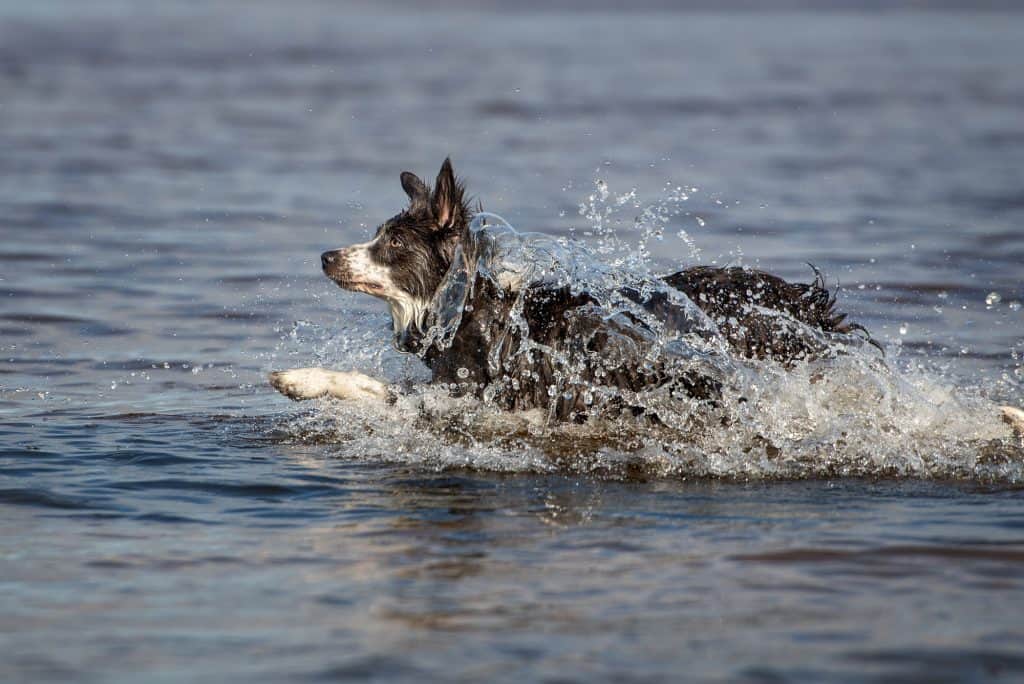Border collies are fast, agile dogs. Their feet are an integrable part of their ability to move quickly. Some dogs have webbing between their toes that allows them to be faster in the water. Many dog owners wonder do Border Collies have webbed feet?
Border Collies are not classified as dogs with webbed feet. Webbed paws are advantageous for swimming and dogs that were bred to swim usually have webbed feet. Border Collies do have some webbing part of the way down their toes, which is the same as most dog breeds.
In this article, we will consider the question of whether Border Collies have webbed feet and which other dogs have webbed feet. The advantages and disadvantages of webbed paws will also be discussed.
What Are Webbed Feet In Dogs?
Webbed feet or paws in dogs refers to skin that grows between the toes. It grows right up until the end of the toes and is seen in each interdigital space.
Do Border Collies Have Webbed Feet?
Border Collies do not have webbed feet in the official meaning of the term webbed feet. Border Collies are a herding breed, and as such, they were bred to work on dry land.
Since they were not bred for working in water or on wet surfaces, they do not need webbed paws like some other breeds.
All dogs have some webbing in between their toes, and the Border Collie has this slight webbing as well.
How Much Webbing Do Border Collies Have?
Border Collies have a small amount of webbing in between the toes.
The webbing extends partially down the toes, with a maximum amount extending to half the length of the toe. This is similar to what is seen on all dogs that do not have webbed feet.
Are There Any Benefits To Having Webbed Feet?
Generally, dogs that have webbed feet are dogs that were bred to swim. These include water retrievers and dogs used to assist in fishing.
The webbing allows the dogs to swim more efficiently. There is a larger surface on the paw to push and pull against the water while swimming.
The greater surface area of the paw also enhances balance while walking, especially through the snow, swamp, or marshy areas. Webbed feet allow the dog to more easily walk along these surfaces.

The dog’s weight is spread over a greater surface area on the paw, making walking easier on the muddy ground.
Some dogs that were bred to dig also have webbed feet. The webbing allows the dogs to move more dirt in one pull of the paw.
Stability and balance are also enhanced on flat surfaces by interdigital webbing.
Are There Drawbacks To A Dog Having Webbed Feet?
There are some drawbacks to dogs having webbing on their paws. If the dog is walking over rocky terrain, the webbing may be more prone to injury.
If not checked carefully and injuries are not disinfected, the wounds can quickly turn into abscesses. Abscesses on the feet are extremely painful and can cripple a dog until they heal.
In dogs that swim a lot, the webbing may make the foot more prone to fungal infections if the paws do not dry completely.
Another problem is that parasites such as ticks are prone to biting into the webbing on the feet. This thin skin gives the parasites easy access to blood vessels that are relatively close to the surface.
Ticks carry diseases that will make the dog sick and can prove fatal. In addition, ticks sometimes cause excruciating, deep, necrotizing wounds.
Dog Breeds With Webbed Feet
Several dog breeds have webbed feet. We will look at these breeds briefly and consider why they benefit from having webbed paws.
Newfoundlands
These are great shaggy bear-like dogs. They were bred by fishermen in Canada. They are powerful dogs and were used to pull fishing nets laden with fish and boats out of the water.
Their waterproof coats and webbed feet make them ideally suited to swimming in the icy cold waters around Canada. They are known as being some of the strongest swimmers in the dog kingdom.
Labrador Retrievers
Labradors are well-known loveable clowns used for retrieving game on land or in the water. They adore swimming and spend as much time in the water as they can.
Webbed feet are seen primarily in Labradors bred from working lines. Pet Labrador lines are often seen without webbed feet.
Chesapeake Bay Retrievers
These dogs are retrievers with a similar build to Labradors – with the difference being their wavy coats.
Just like Labradors, they are very loyal and are crazy about water. They were and still are used for hunting ducks in the Chesapeake Bay in Maryland, and Virginia.
The water there can get icy in the colder months, and their webbed feet help them to be efficient swimmers, allowing them to spend the least amount of time possible in the frigid waters.
Nova Scotia Duck Tolling Retrievers
The Nova Scotia breed are retrievers that also toll. Tolling refers to the dog’s ability to lure prey into traps or shooting range.
They work for long periods in the water, and so webbed feet are a must for this breed. They have a reputation for being agile, fast swimmers.
Poodles
Poodles are often thought of as fashion accessories or fancy dogs with no particular function. The truth is very far from this.
Poodles were bred initially in France for two purposes: to retrieve waterfowl from waterways and game birds on the land.
They have webbed feet, which assisted them when swimming to retrieve game birds from the water. The webbed feet also helped to give them grip when they retrieved game birds on land.
Portuguese Water Dogs
These dogs were bred to be herders of a different kind. They herded schools of fish into the fishermen’s nets.
As you can imagine, they needed to be extremely strong swimmers, and their webbed feet helped them achieve this. Pet Portuguese water dogs still love being in the water and will swim at every opportunity.
American Water Spaniels
American Water Spaniels are known for their thickly padded feet with webbed toes. Their skin exudes oils that repel water from their coats.
Irish Water Spaniels
These Spaniels have a thick curly coat that protects them from the cold Irish waters. Pair this with webbed feet, and you will understand why they are popular retrieving dogs in Ireland and beyond.
German Wirehaired Pointers
German Wirehaired Pointers have webbed paws and a wiry coat that provides insulation from the summer heat and protects them from the cold in winter. They are dogs that can do water retrievals when hunting with their owners.
German Shorthaired Pointers
German Shorthaired Pointers do not have a coat that protects them from the cold, but they do have webbed feet that allow them to retrieve waterfowl.
Weimaraners
Weimaraners are another hunting dog that is used for water retrieval.
In the eighteenth century, their striking looks and webbed feet made them a popular choice amongst royal hunters across Europe.
They have noticeably arched toes with interdigital webbing, which assists them on both land and water.
Otterhounds
These are large, shaggy, goofy dogs that love to play in and out of the water. They were used in previous times to hunt otters, but this has now been outlawed.
The dogs are currently used in other hunting or as pets. They are scent hounds that are on the endangered dog list.
They have webbed feet as swimming was essential when hunting otters.
Redbone Coonhounds
Redbone Coonhounds were deliberately bred for hunting in marshy areas. They hunted a variety of game but were mainly used for hunting raccoons – hence their name.
Their webbed feet helped them to traverse swamps and muddy ground with ease.
Dachshunds
Nicknamed ‘sausage dogs’, these dogs are small and long-bodied with webbed feet. They, however, do not swim as part of their job.
Their webbed paws assisted them with digging rabbits, hares, ferrets, badgers, and other vermin from their burrows.
American Bulldogs
American Bulldogs also have webbed feet. They were not bred to have webbed feet for any particular purpose.
Bulldogs have tiny feet for their body size and mass. Their webbed feet help to distribute the pressure from the heavy bodies over a greater surface area.
Many American Bulldogs have problematic foot issues relating to webbing between their toes. Their short bristly hair is sometimes pushed back into the webbing, creating infected, pus-filled wounds.
Infected hair follicles can occur repeatedly and are painful enough to make the bulldog reluctant to move.
Conclusion
Border Collies only have minor webbing on their feet and are not classified as having webbed feet. Even the small amount of foot webbing seen on Border Collies helps them balance, stabilize and move on land. Dogs with fully webbed feet have an advantage in digging, swimming, and moving over muddy swamps in a more agile manner.
If you are looking for a dog breed that moves quickly in the water, consider one of the breeds listed above as having webbed paws.

